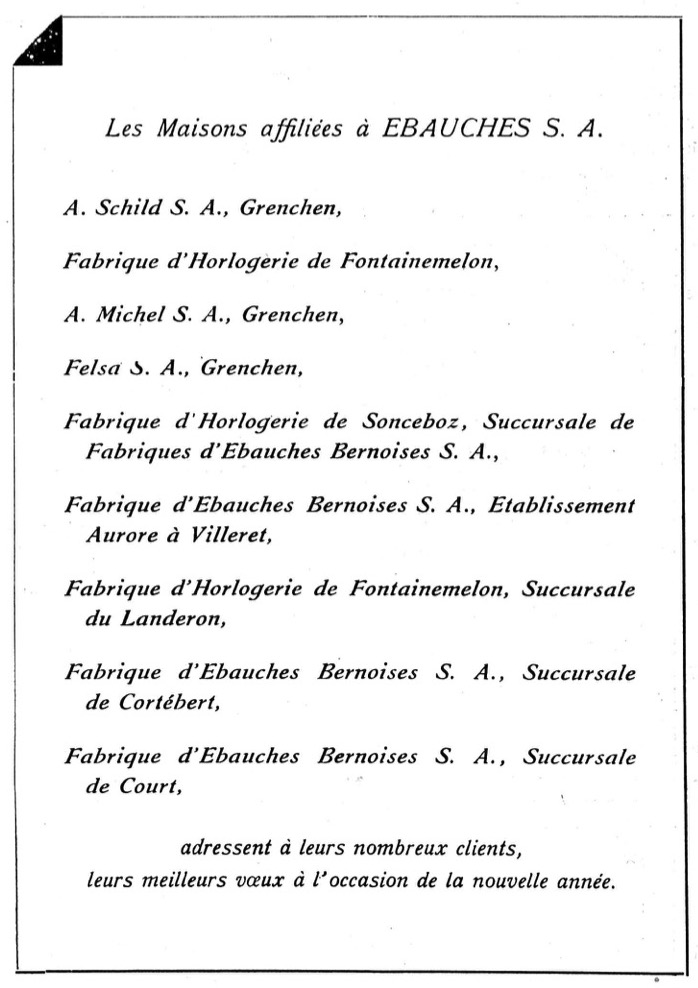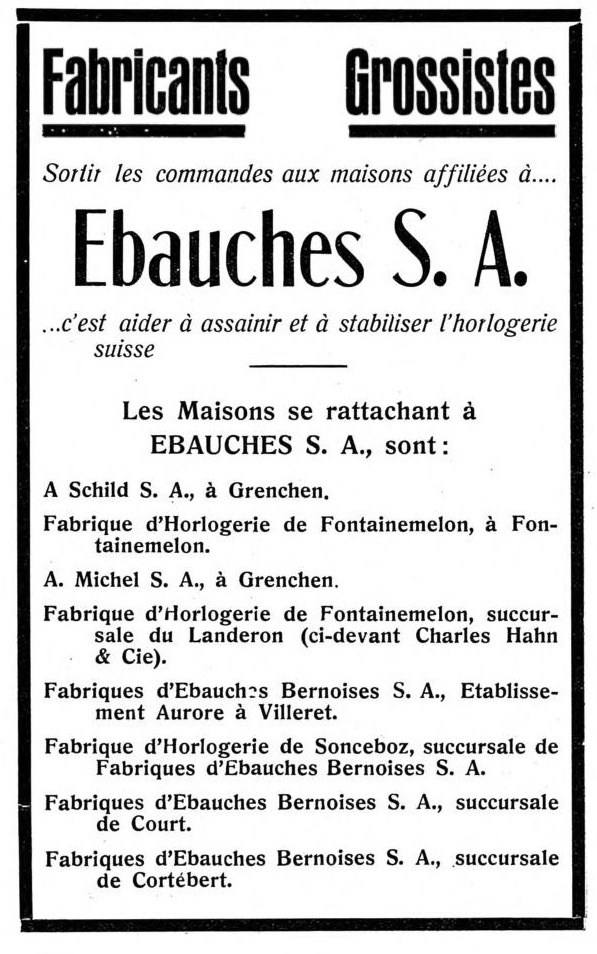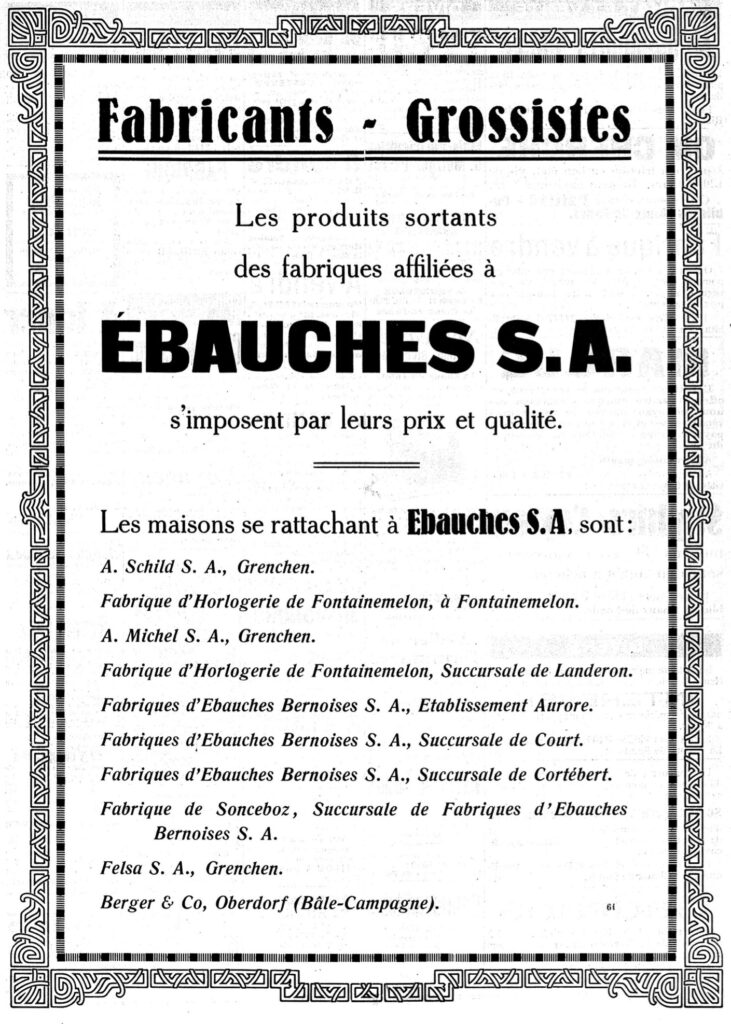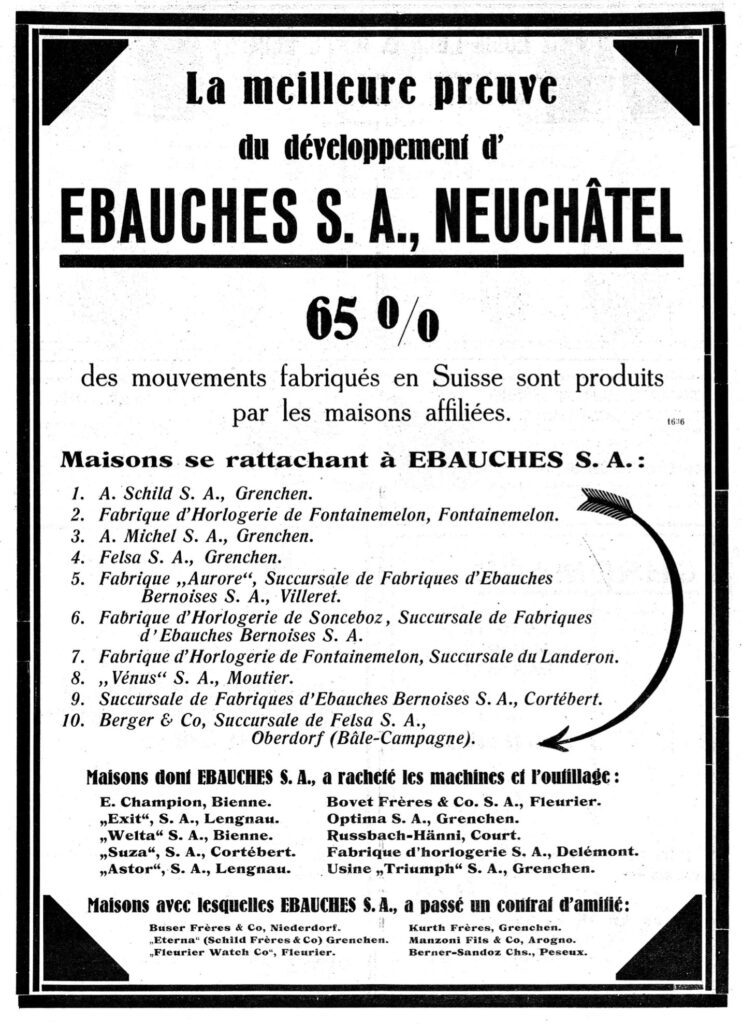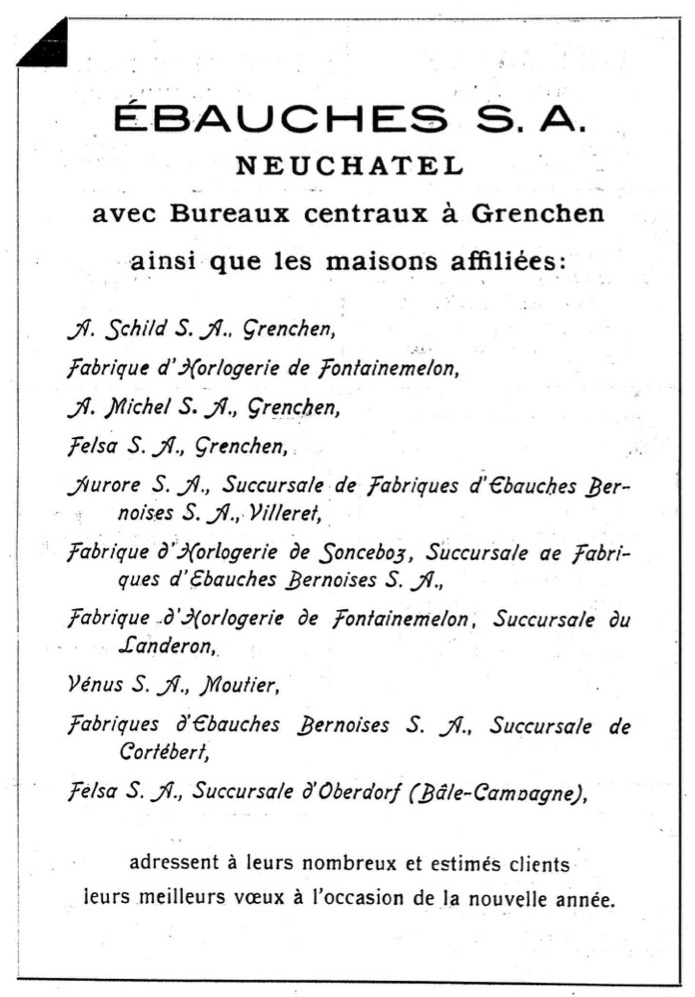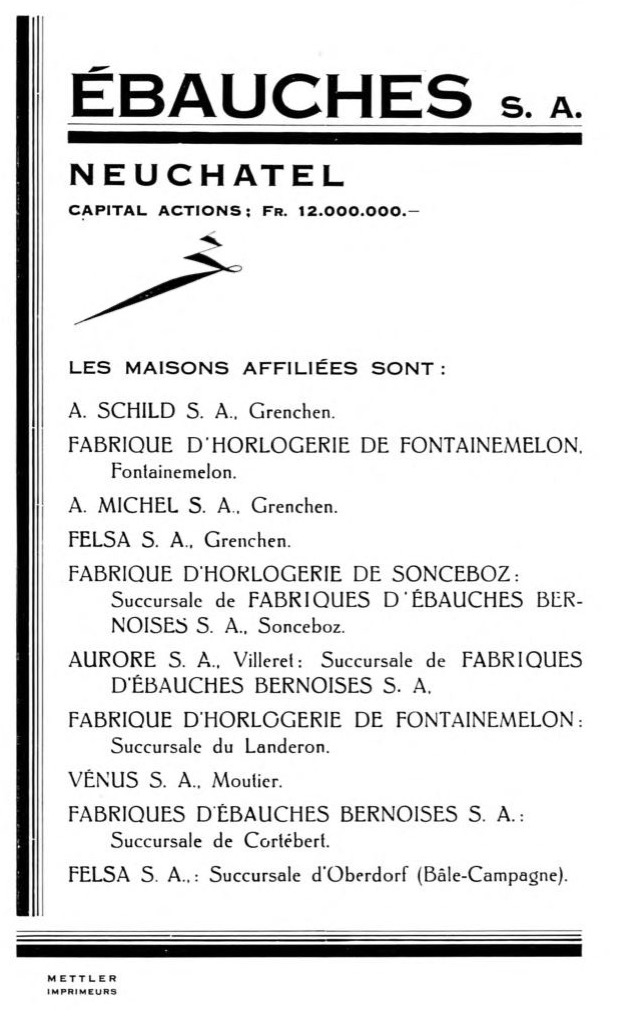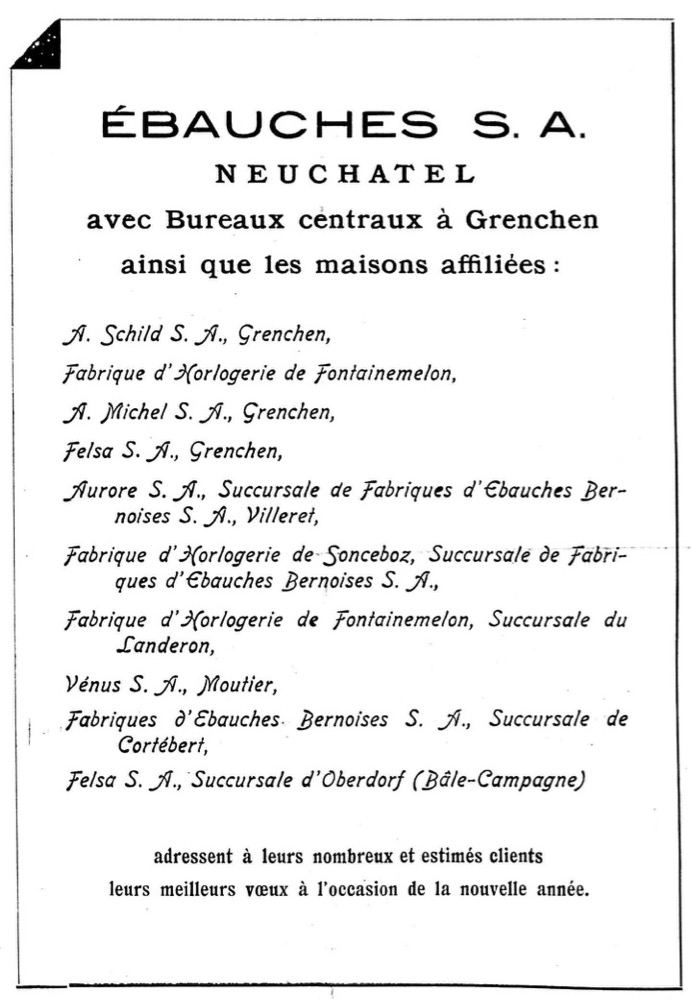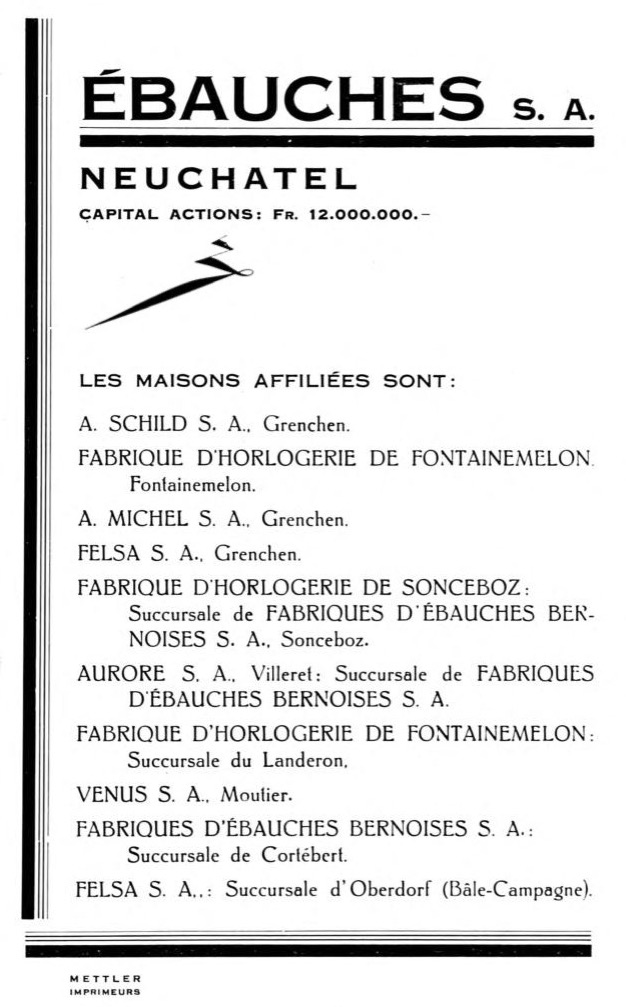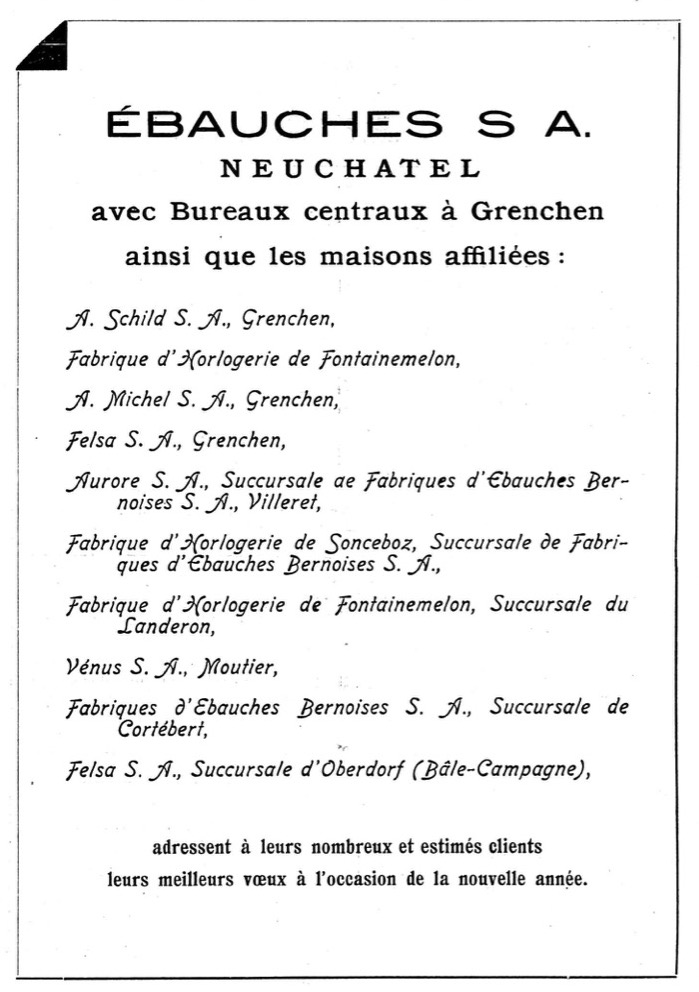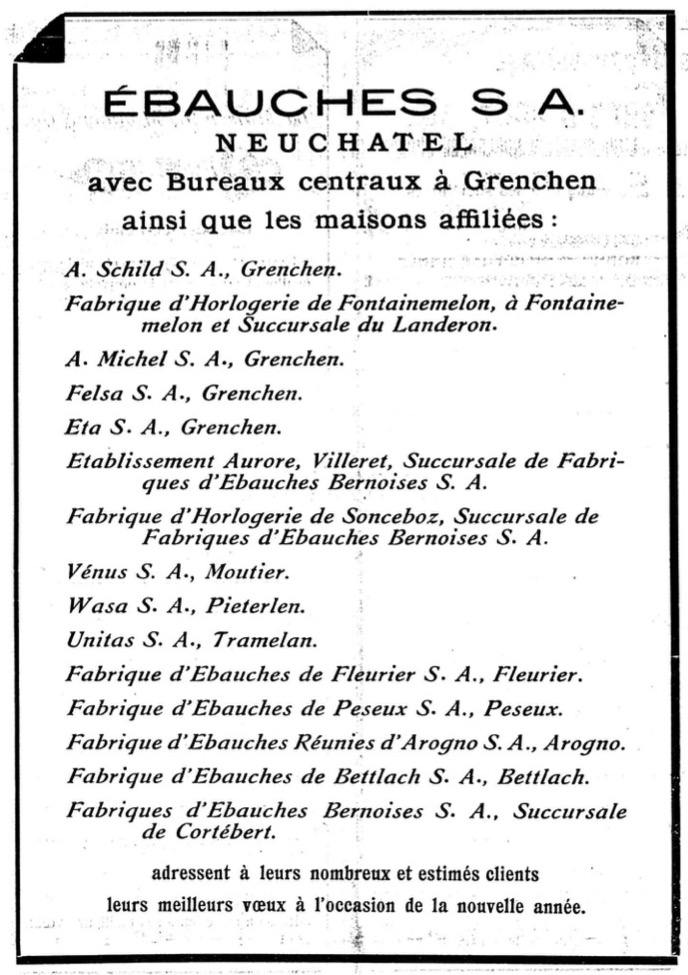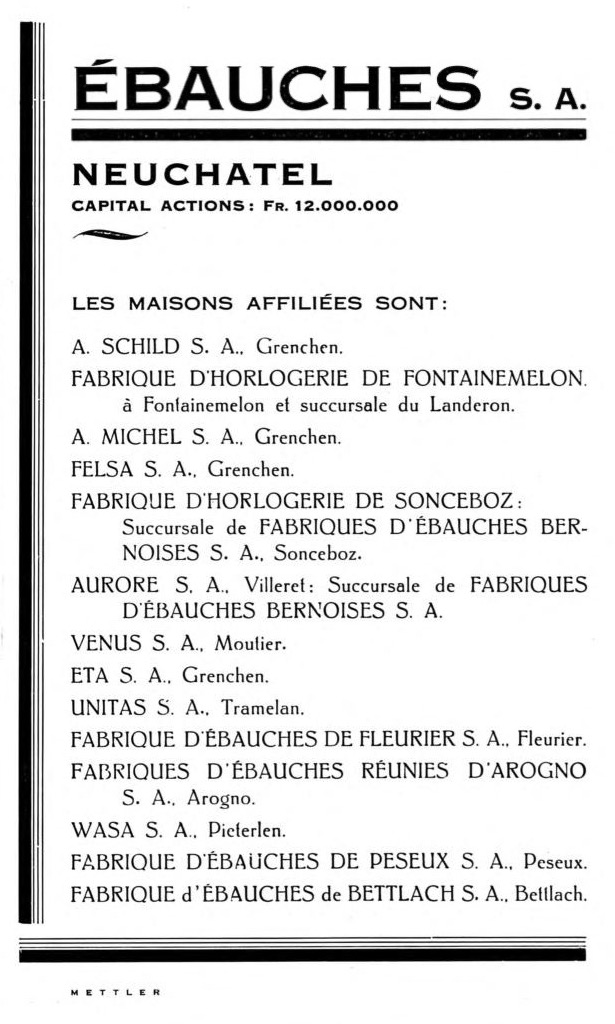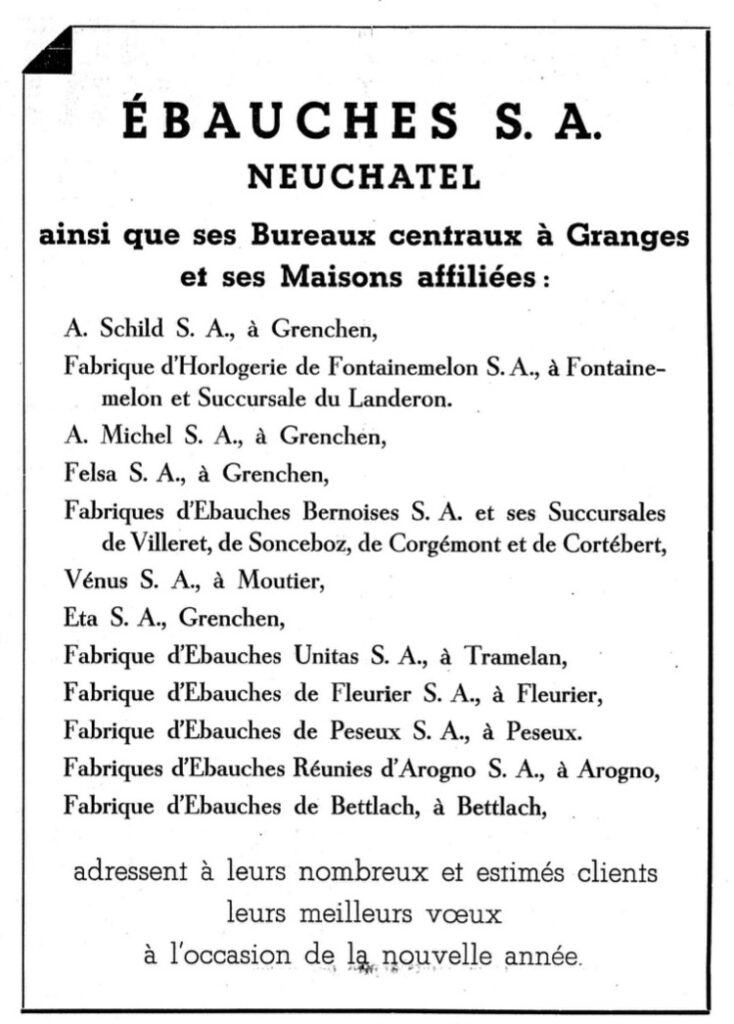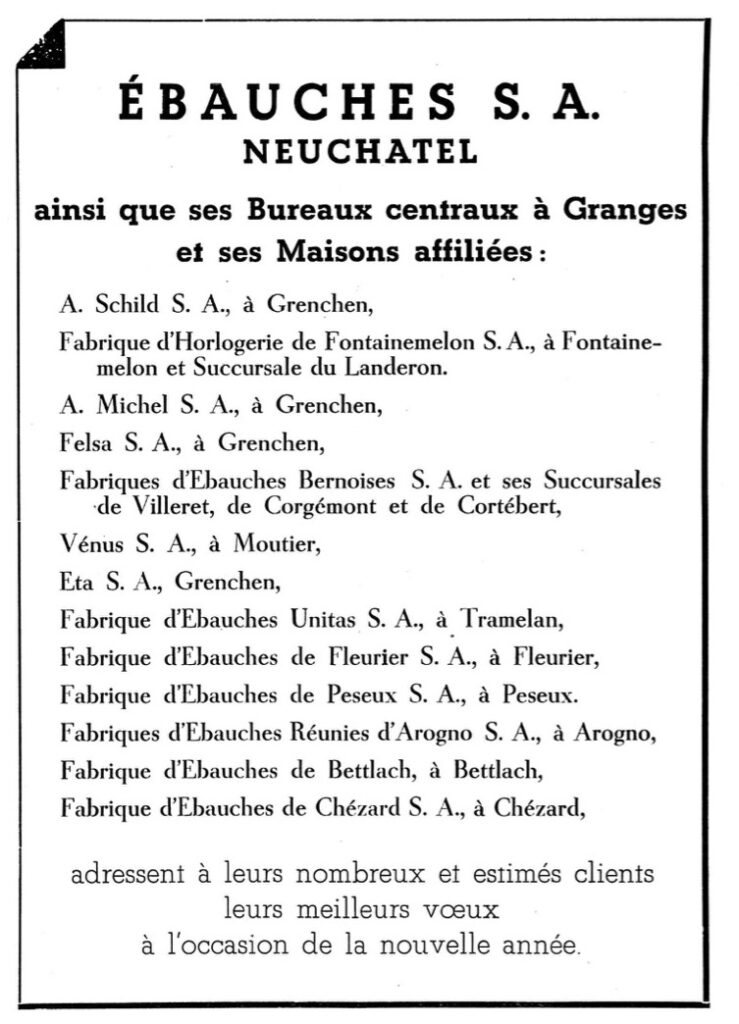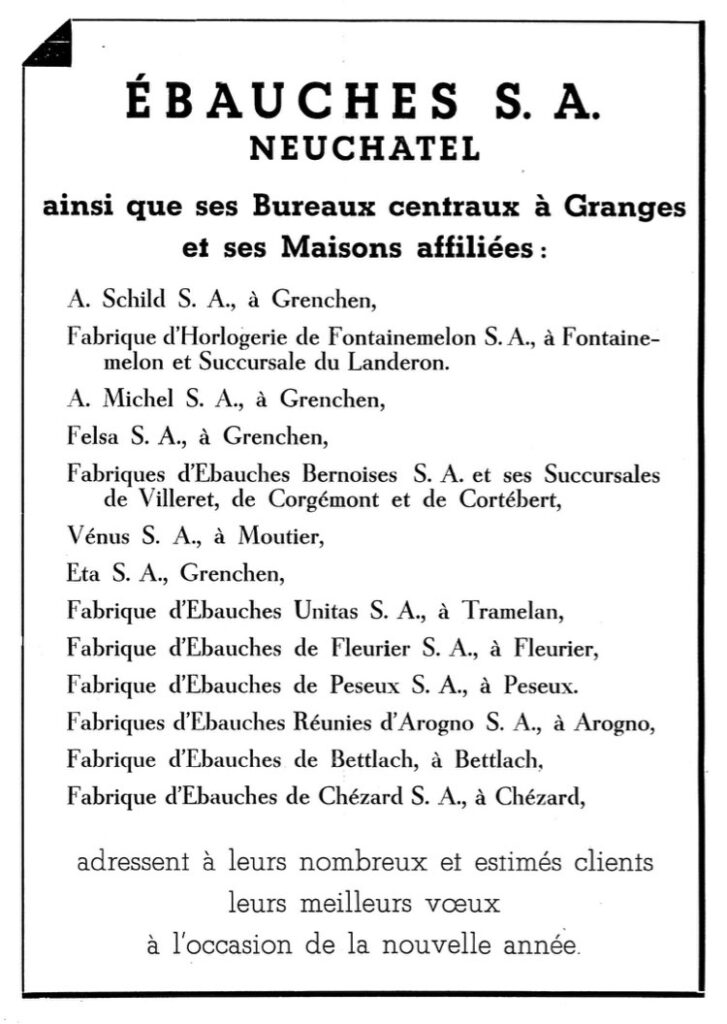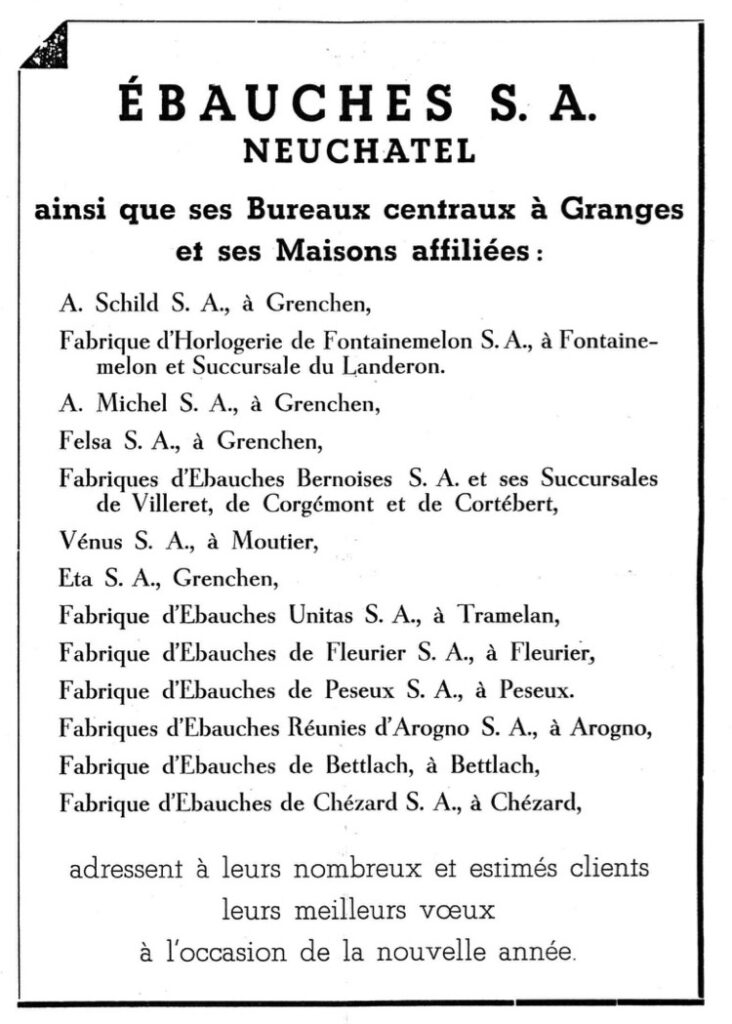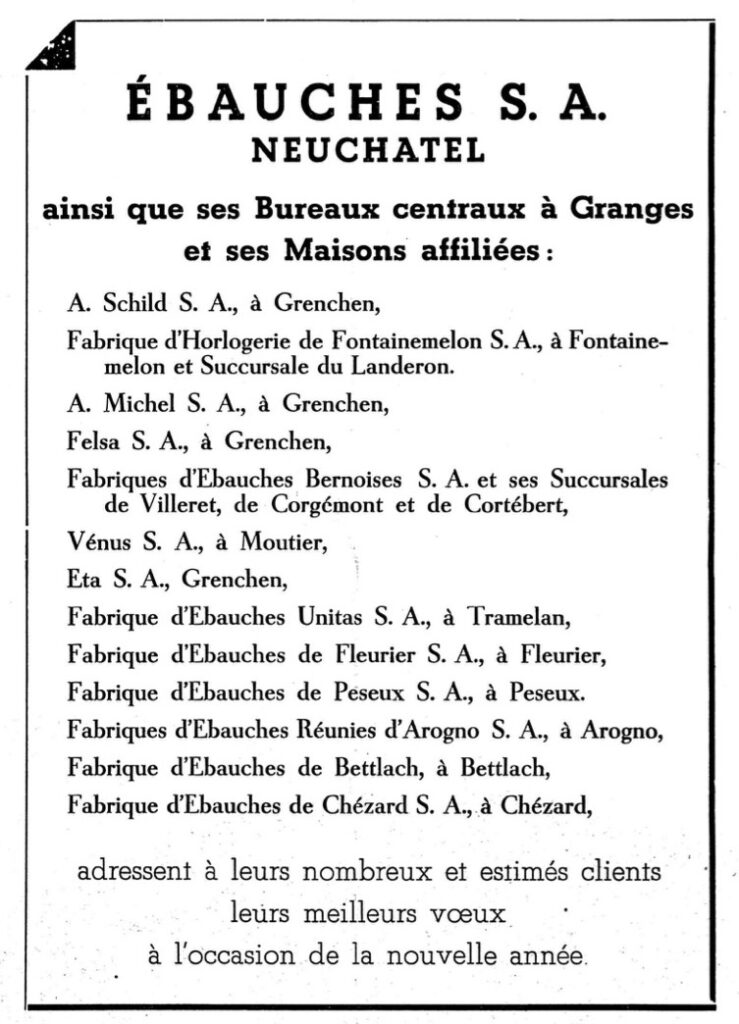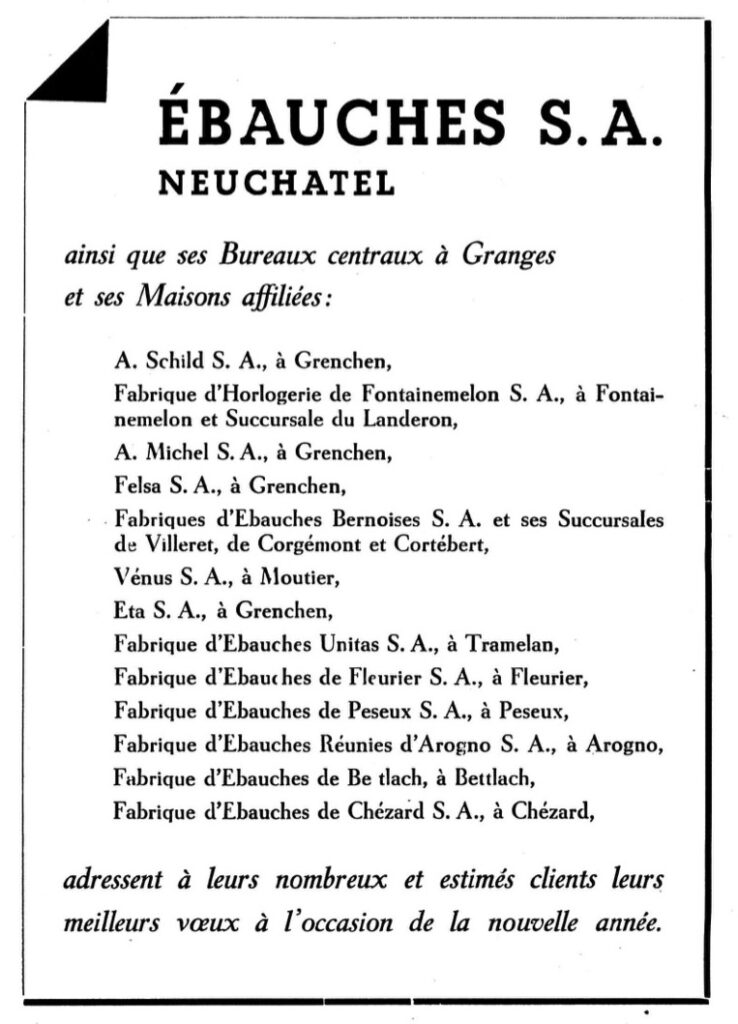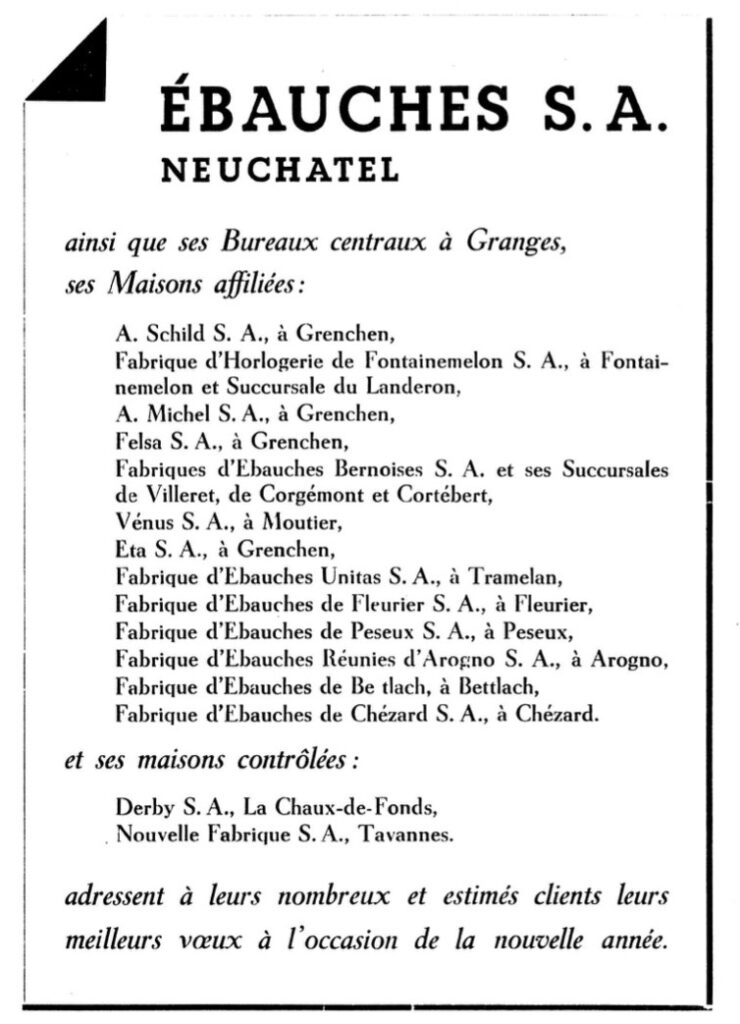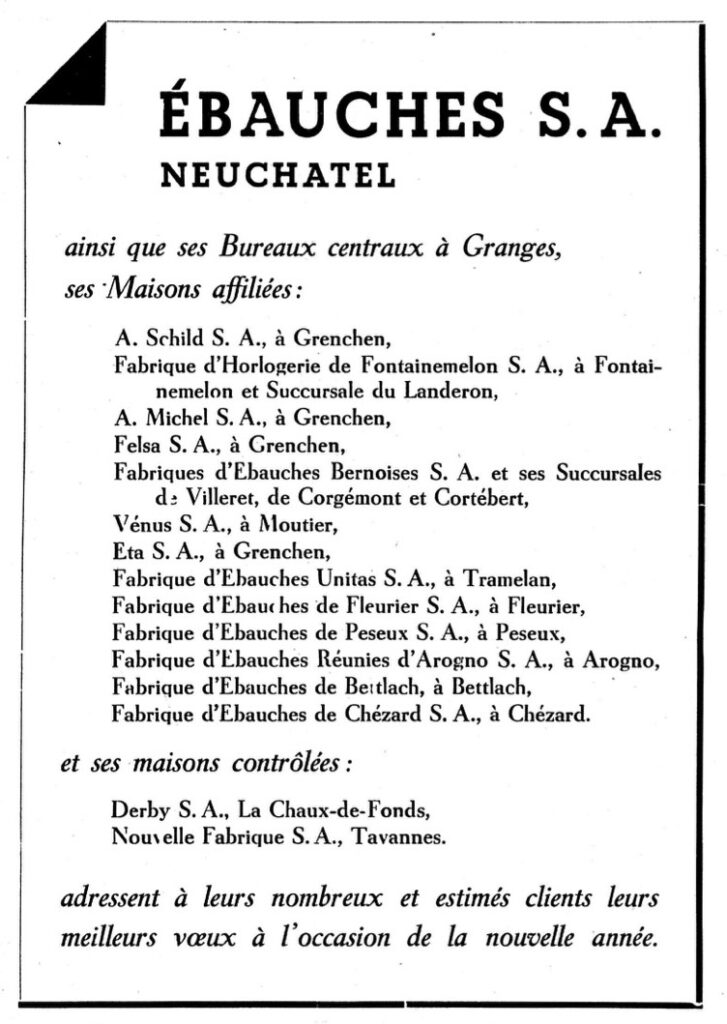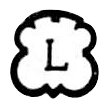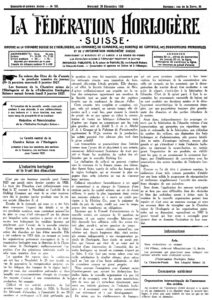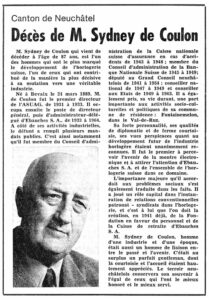Ebauches SA Logos
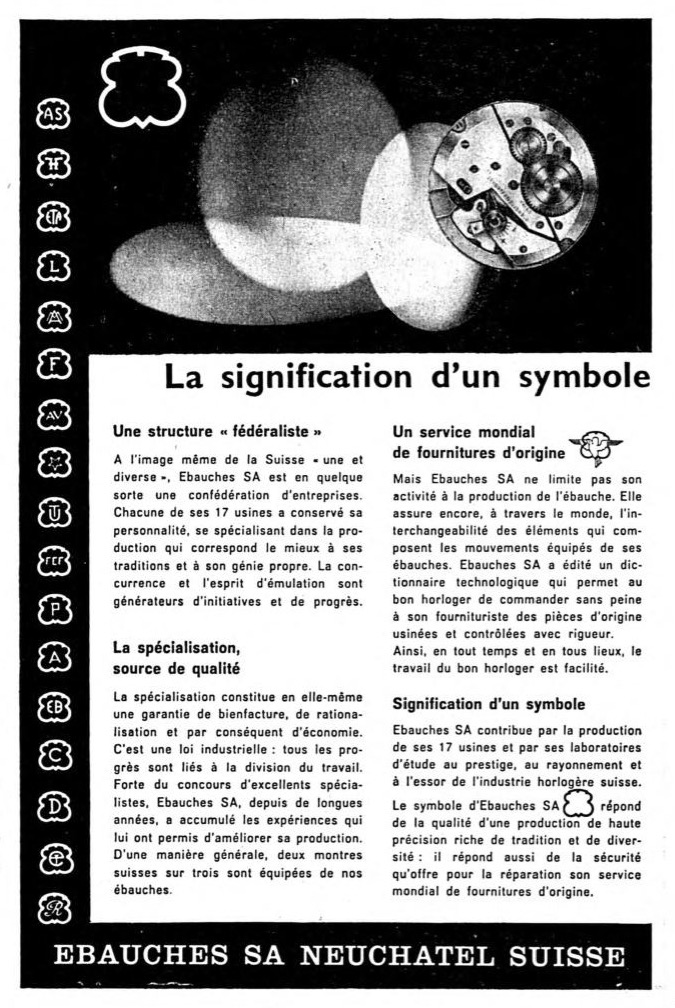
Ebauches SA adopted a shield logo by 1939, with each affiliated company placing their own logo in the shield. Grail Watch has identified 28 logos in total, 17 of which are shown on the Europa Star table below.
Most of the Ebauches SA shield logos are somewhat obvious, being the initial of the company or factory location, but others are a little more obscure. Fabriques d’Ebauches Bernoises consisted of factories in Cortébert, Soncéboz, Villeret, Court, and Porrentruy, but it takes the “AV” from “Aurore-Villeret.” Vénus SA uses a star, its historic symbol/ Valjoux SA uses the “R” in reference to the Reymond brothers who founded the company. “T” for “Tavannes” overlaps the “U” for Unitas.
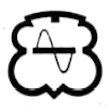
Some of the rarer shield logos include the radio wave used by Oscilloquartz, which is not seen in the table below. Other later logos include EEM, ESA, INT, MPG, ST, and SWG. Ebauches SA also used a dove logo to represent the whole company.
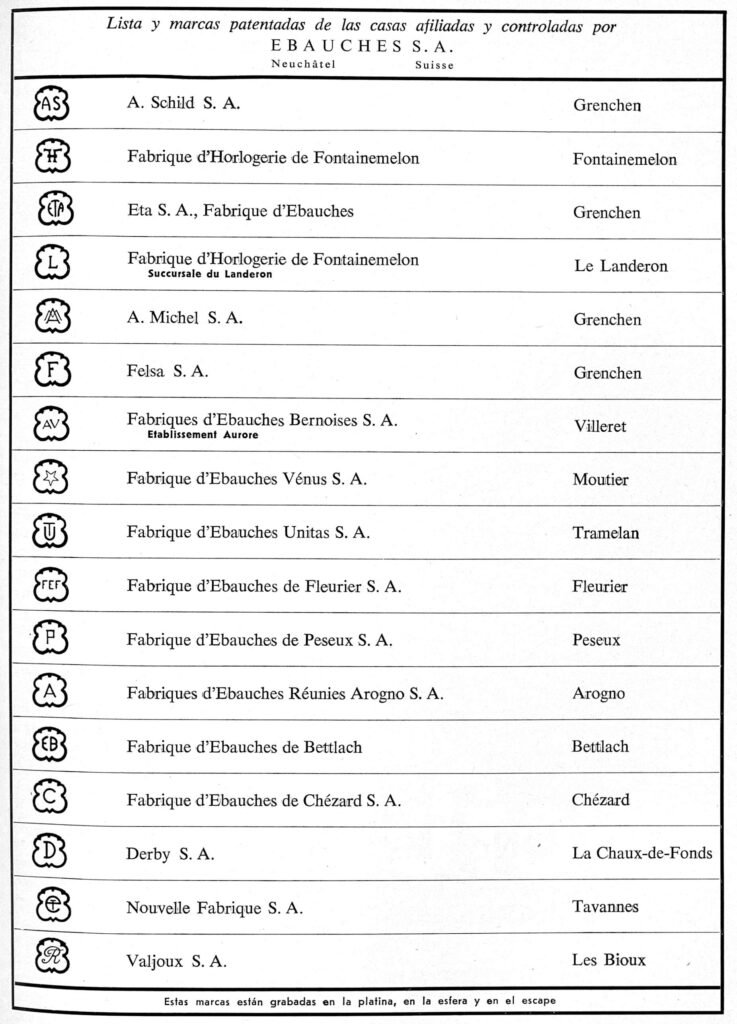

ETA, the successor to Ebauches SA, retains their original logo, which incorporates a round representation of the company’s initials. This pre-dates Ebauches SA, being first seen in 1925. Previously, ETA used block letters, sometimes with an oval around them.
The modern ETA has not retained the various factory logos used by their predecessor companies, however. The major ebauche factories in Fontainemelon, Grenchen, Moutier, and Bettlach all use bear the ETA name. But the continued presence of the traditional shield suggests this long history.
Predecessor Companies
1793
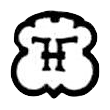
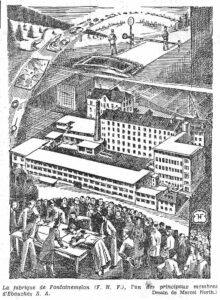
Image: l’Impartial, April 28, 1952
Isaac and David Benguerel and Julien and Francois Humbert-Droz establish Benguerel & Humbert on October 31, 1793, a watch movement manufacture in Fontainemelon. This would become Fabrique d’Horlogerie de Fontainemelon (FHF), one of the founding members of Ebauches SA.
1816

Benguerel & Humbert begins mass production of ebauches at a new factory in Fontainemelon. It would soon become the leading ebauche manufacture in Switzerland.
1825

Jacob-Robert Tissot takes over the firm of Benguerel & Humbert on January 1, 1825, following the death of his father-in-law, Julien Humbert-Droz. Now known as Robert & Cie, it would take the name of the village of Fontainemelon 50 years later and become a founding member of Ebauches SA 100 years later.
1838

Robert & Cie purchase a water-powered factory in Corgémont to increase production, abandoning oxen power in Fontainemelon.
1844
On December 31, 1844, Aimé-Auguste and Charles-Alfred Hahn found the watchmaking firm of Hahn Frères. They would move the company to Le Landeron in 1875, where it would focus on ebauche production.
1845
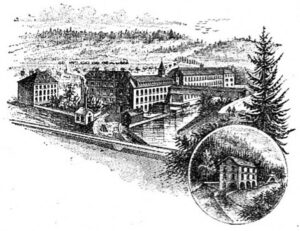
The firm of Rosselet & Challandes is established in Sonceboz. It would become Fabrique d’Ebauches de Sonceboz in 1882 and would join Hora in Cortébert and Aurore in Villeret to become Fabriques d’Ebauches Bernoises in 1927, joining Ebauches SA later that year.
1851
On January 16, 1851, the municipal assembly of Grenchen (Granges) voted to introduce watchmaking to the village. Thanks to this effort, Grenchen remains the most important location for ebauche production and the home of the modern-day ETA.
1856
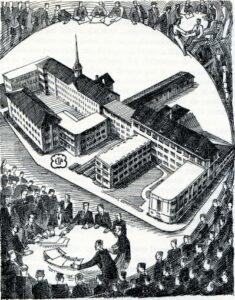
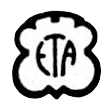
Physician Dr. Josef Girard and school teacher Urs Schild found the raw movement manufacturer Dr. Girard and Schild Ebauches in Grenchen. The company’s movement operations would become part of Ebauches SA as ETA in 1932 and this factory remains in operation today at Schild-Rust Strasse 17 as ETA’s Werk 01.
1858
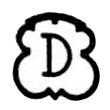
Watchmaker F. Wuilleumier begins operation in Renan. He would specialize in pedometers, early automatic watches, and measurement devices. The company would be renamed Pedos SA in 1929, moved to La Chaux-de-Fonds and became Derby SA in 1939, and would be the foundation for Ebauche Electroniques SA of Marin (EEM), Ebauches SA’s electric, electronic, and quartz watch specialist in the 1970s.
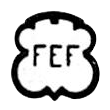
Watchmaking in Fleurier is established. The Fleurier Watch Co. would be created in 1915 and its Fabrique d’Ébauches de Fleurier would become part of Ebauches SA in 1932.
1862

The Robert & Cie factories in Corgémont and Fontainemelon begin to experiment with steam power. The factories dominated ebauche production in Switzerland through the 19th century.
1865

Jacob-Robert Tissot dies, leaving control of Robert & Cie and the Fontainemelon and Corgémont factories to his two nephews.
1866

Dr. Girard retires, selling his share of the Grenchen watch factory to Urs Schild. Some claim that the Eterna brand debuts around this time.
1875
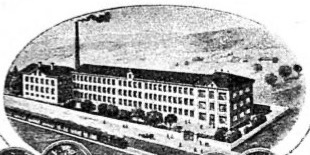
Charles Alfred and Aimé Auguste Hahn establish a watch factory in Le Landeron as Hahn Frères, shuttering their existing business in La Chaux-de-Fonds shortly afterward. It would merge with Fabrique d’Horlogerie de Fontainemelon (FHF) in 1925 and thus become a founding member of Ebauches SA in 1926.
1876

Robert & Cie.’s Fontainemelon and Corgémont company is formally incorporated as Fabrique d’Horlogerie de Fontainemelon SA (FHF), the leading ebauche manufacturer and foundation for Ebauches SA.


Urs Schild builds a modern factory in Grenchen to produce ebauches in competition with FHF.
1882

21 year old Jules Jéquier and mechanic David-Louis Petitpierre establish an ebauche factory in Fleurier to supply the markets in China and England. It would evolved into Fabrique d’Ebauches de Fleurier and would join Ebauches SA in 1932. Petitpierre would leave the business a few years later.
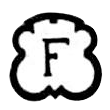
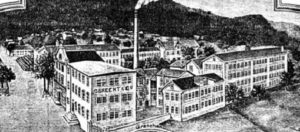
Eduard Kummer joins Obrecht & Cie in Grenchen and attempts to take over the company. Failing, he returns home to Bettlach to found his own company. Felsa would take over the massive Obrecht factory in 1924, bringing it into Ebauches SA in 1928. Kummer’s Bettlach factory would join as well a few years later.
On October 19, 1882, the existing firm of Rosselet & Challandes in Sonceboz established the Fabrique d’Ebauches de Sonceboz. It would join Hora in Cortébert and Aurore in Villeret to become Fabriques d’Ebauches Bernoises in 1927, joining Ebauches SA later that year.
1888
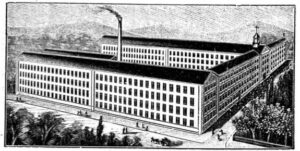
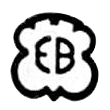
Eduard Kummer opens a new ebauche factory in Bettlach near Soleure specializing in inexpensive pin lever and Roskopf movements. It would be absorbed into Ebauches SA as Fabrique d’Ebauches de Bettlach in 1932 and 1940.

Urs Schild-Rust dies on April 25, with his brother Adolph Schild taking over the Grenchen watch movement factory along with his widow and sons. It is now known as Gebr. Schild & Co.
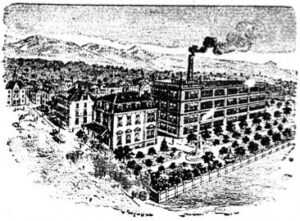
Adolphe Kurth establishes his watchmaking operation in Grenchen. He is later joined by his brothers, Alfred and Emile, in Kurth Frères, one of the largest producers of watches for women. Kurth would become a partner of Ebauches SA in 1928 and would join General Watch Co. and ASUAG in 1971. The Grana/Kurth factory in Grenchen is ETA’s W06 factory today.
1889
The Le Landeron ebauche factory Hahn Frères is re-named Charles Hahn & Cie under the son of one of the founding brothers.
1892

Jules Jéquier’s sons, Jules and Charles, join the Fleurier firm, which is now called Jéquier Frères & Cie.

Auguste Sandoz convinces the citizens of Chézard to put up the money to construct a large ebauche factory there. Sandoz & Cie. will produce his design, which was shrouded in lawsuits by Japy Frères.
1896

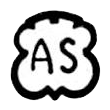
Adolph Schild forms his own movement manufacture in Grenchen, A. Schild SA (ASSA). It would be a founding member of Ebauches SA in 1926.
1897

Jules Jéquier retires from the Fleurier factory, leaving it to his sons as Jéquier Frères. But they soon go split as well, with each running his own factory in Fleurier.
1898
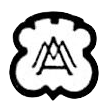
Adolphe Michel SA (AMSA) is founded in Grenchen by Adolphe Michel and Jean Schwarzentrub. It would become a founding member of Ebauches SA in 1926.
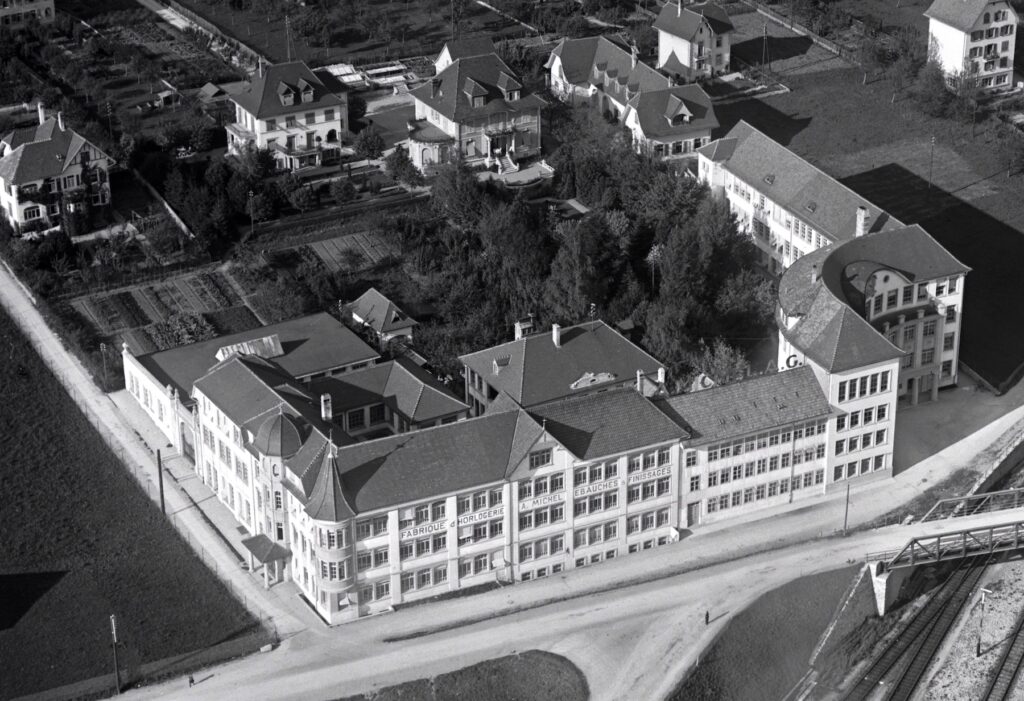

Auguste Reymond establishes his namesake watch company in Tramelan. He would begin production of his own ebauches around 1906 and would purchase the Unitas Watch Company in 1926, adopting that name. After staunchly resisting consolidation, Reymond would sell Unitas to Ebauches SA in 1932.
1899
Baumgartner Frères is founded in Grenchen. The factory would join Ebauches SA in 1926.

Theodor Schild takes over his family’s movement manufacture in Grenchen, now officially called Schild Fréres but commonly known as Eterna. The company’s movement operations would become part of Ebauches SA as ETA in 1932.

1900

Paul Robert introduces American-style mass production techniques and machinery at one workshop of Fabrique d’Horlogerie de Fontainemelon (FHF).

The third Jéquier brother, Paul, forms his own ebauches factory in Fleurier along with his brother-in-law William Borle.
1901
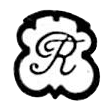
John and Charles Reymond establish a workshop in the Vallée de Joux to produce chronograph movements. The company, then known as J. & C. Reymond Frères, would become famous under the name of Valjoux, which would merge with Ebauches SA in 1944.
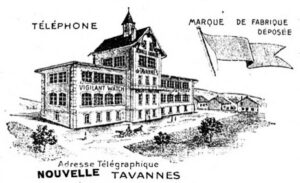
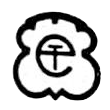
The citizens of Tavannes build the Nouvelle Fabrique de Tavannes and lease it to Salomon Hirsch of La Chaux-de-Fonds. It produces watches for Achille Hirsch before coming under control of Ebauches SA in 1932.
1902
The Charles Hahn & Cie factory in Le Landeron is expanded as electric power replaces steam.
1910

The municipality of Les Bioux builds a new factory for the Reymond brothers’ firm, which was reorganized as Reymond Frères SA and employed 30 people. It would become known as Valjoux.
1915
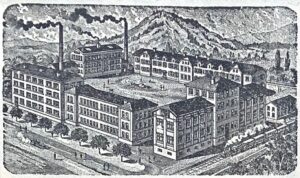

The three Fleurier factories founded by the Jéquier family merge to become the Fleurier Watch Co.
1918
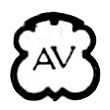
On July 1, 1918, a watch factory is founded between Saint-Imier and Villeret called Guerrin, Bourquin & Cie. It produced watches under the Aurore brand, and the Aurore-Villeret ebauche factory would join Ebauches SA in 1927 as part of Fabriques d’Ebauches Bernoises SA.

On September 16, 1918, the Fabrique d’Ebauches et de Finissage Felsa SA is formed in Longeau (Lengnau) near Bienne. It would take over the Obrecht factory in Grenchen in 1924 and join Ebauches SA in 1927.
1919
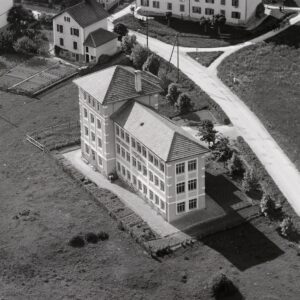
Hora SA is established in Cortébert on September 28.
1920

The Fleurier Watch Co. takes over the Jeannin-Rosselet factory in Buttes and separates the watchmaking from the ebauche business. The Fabrique d’Ebauches de Fleurier would join Ebauches SA in 1932.
1923
The Swiss Chamber of Watchmaking takes up the idea of a consolidated holding company for ebauche manufacturers but the idea is defeated on the objection of one of the main producers.

The watch movement operations of Schild Fréres are re-branded using the ETA name, with Eterna being used only for finished watches. ETA would become part of Ebauches SA in 1932.
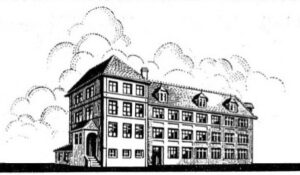
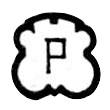
Fabrique d’ebauches de Peseux SA is registered in Peseux by Charles Berner on September 24, 1923. It is noted in his obituary that the factory already existed prior to this date, but the young Berner, who recently arrived from Val-de-Travers, established it as a new company at this time. Charles Berner-Sandoz would sign a cooperation agreement with Ebauches SA by 1928 and his company would become part of the group in 1932. He would manage the firm until his health declined in 1949 and his death in 1951.

Obrecht & Cie. of Grenchen is liquidated in February. On May 6, 1923, Felsa SA moves from Longeau to Grenchen, taking over the former factory.
1924
Fabrique d’ébauches Vénus SA is founded on May 1, 1924 in Moutier-Grandval by Paul Berret, his brother Jean-Baptiste, and Otto Schmitz. The company would join Ebauches SA just four years later.

On June 17, 1924, Fabrique d’Ebauches et de Finissage Felsa SA moves to Grenchen, taking over the former Obrecht & Cie factory there and simplifying its name to Felsa SA.
1925
Charles Hahn & Cie in Le Landeron is merged into Fabrique d’Horlogerie de Fontainemelon (FHF), becoming Fabrique d’Horlogerie de Fontainemelon, Succursale du Landeron.

Charles Reymond retires from Reymond Frères SA, leaving the company to John Reymond and his sons.
Establishment of Ebauches SA
1926
The 28-member Society of Ebauche Manufacturers unanimously votes to study the financial viability of an ebauche holding company, instructing the Swiss Trust Company to audit the finances of prospective members.
June 25, 1926: The ebauche holding company concept is brought to a conference in Neuchâtel, with the companies agreeing in principle.
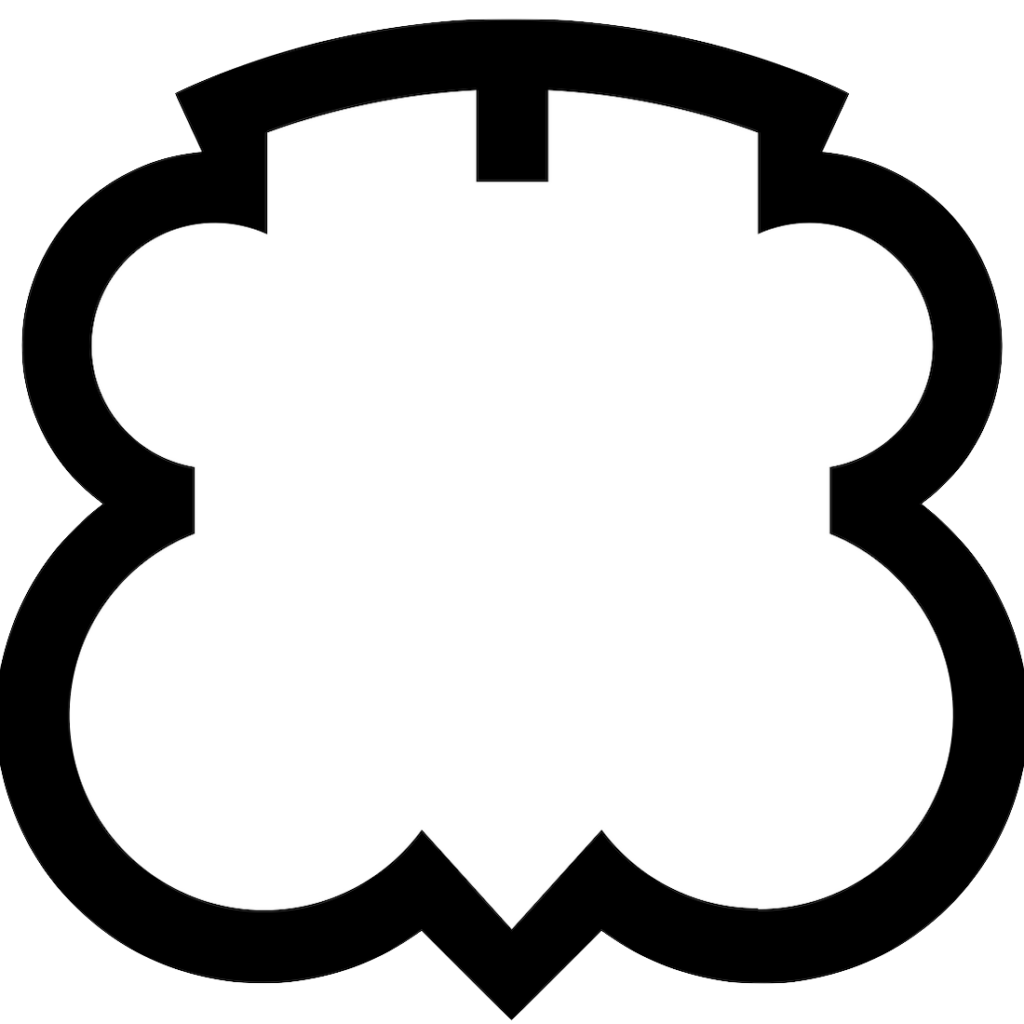



December 27, 1926: Ebauches SA is founded in Neuchâtel by A. Schild SA (ASSA) of Grenchen, Adolphe Michel SA (AMSA) of Grenchen, and Fabrique d’Horlogerie de Fontainemelon (FHF), which together accounted for 75% of the production of the Society of Ebauche Manufacturers.
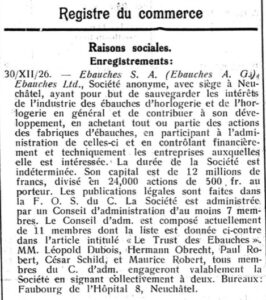
The initial investment is 12 million Swiss francs, and the company is supported by the Banque Cantonale Neuchâteloise, the Banque Cantonale Bernoise, the Banque Populaire Suisse, and the Société de Banque Suisse. Léopold Dubois of the Banquet Suisse is Chairman, Hermann Obrecht is first vice-president, Paul Robert (FHF) is second vice-president. The board consists of César Schild, Adolphe Schild (ASSA), Gottleib Vogt-Schild, Maurice Robert, Emile Hindenlang, Hermann Stadlin, Ernest Scherz, and Gottfried Scharpf. Sidney de Coulon was elected outside secretary.
1927
Fabrique d’Horlogerie de Fontainemelon, Succursale du Landeron (formerly Charles Hahn & Cie or simply Le Landeron) is listed as a member of Ebauches SA under FHF by September, though the company was acquired by FHF a year before the founding of Ebauches and thus was already part of the group.

Fabriques d’Ebauches Bernoises SA (formerly Hora SA) of Cortébert is expanded on June 7, adding subsidiaries Fabrique d’Horlogerie de Sonceboz of Sonceboz/Sombeval and Aurore SA (formerly Guerrin-Bourquin & Cie.) of Villeret. Bernoises joins Ebauches SA by September and the companies formally re-incorporated in November. Branches in Porrentruy and Court were also part of Bernoises.

Felsa SA of Grenchen joins late in 1927. Berger & Co. of Oberdorf joins as a branch of Felsa soon after.
1928

65% of all watch movements made in Switzerland are produced by Ebauches SA by the end of 1928.
Vénus SA of Moutier joins by March, 1928.
E. Champion of Bienne (failed March 21, 1927), Exit SA of Lengnau (failed in 1926), Welta SA of Bienne (failed February 18, 1927), Suza SA of Cortébert/Corgémont, Russbach-Hänni of Court, and Usine Triumph SA of Grenchen are dissolved and purchased by November
Bovet Frères & Co. SA of Fleurier and Optima SA of Grenchen remained in operation but ceased producing ebauches and turned their tooling over to Ebauches SA
According to the annual report, Benoit et Nicolet of Pieterlen, Urania Watch Co. (formerly Urania, Fortuna, La Social, Delta, Goschler & Co.) of Bienne and La Heutte, Astor SA of Lengnau, and Fabrique d’Horlogerie SA of Delémont ceased operation, with the machines and tooling acquired by Ebauches SA, in 1928.
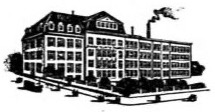

Buser Frères & Co. of Niederdorf, Eterna (Schild Frères & Co.) of Grenchen, Fabrique d’Ébauches de Fleurier of Fleurier, Kurth Frères of Grenchen, Manzoni Fils & Co. of Arogno, A. Reymond SA (Unitas) of Tramelan, Fabrique d’Ebauches de Peseux SA, and Charles Berner-Sandoz of Peseux (Fabrique d’Ebauches de Peseux SA) sign a partnership agreement with Ebauches SA by November. All of these would later be absorbed into Ebauches SA or ASUAG.
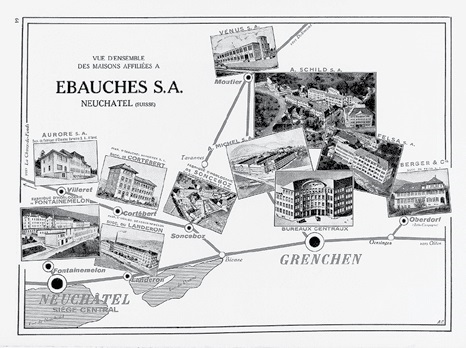
1929
Postala/Chatelain (formerly Jacot et Monnier and Gagnebin et Nicolet, Niga or Luc-Albert Chatelain) of Tramelan-Dessous join

Reymond Frères SA in Les Bioux is renamed Valjoux SA. It would join Ebauches SA in 1944.
1931
Ebauches SA is a founding partner of ASUAG on August 14, 1931.

Ebauches SA is one of a trio of industry alliances attempting to restrict production and sale of watch components, especially exports. The company receives 13.5 million francs from the Swiss Confederation to purchase the eight so-called “dissident” ebauche manufacturers, most of which are acquired or forced out of business in the next few years. Just two firms, Rossé & Affolter of Court and Meyer et Fils of Pieterlen, refuse to sell.
1932


Unitas (formerly A. Reymond SA) of Tramelan is another large dissident factory but is purchased by December after reorganization February 5, 1932.

Schild Frères of Grenchen, the largest of the dissident firms, is purchased and split up. The Eterna watch operation becomes part of ASUAG while the movement arm, now called ETA SA, is added to Ebauches SA on March 21, 1932. Schild had previously signed a “friendship contract” which obligated them to abide by Ebauches SA’s terms.
Compact and shaped movement specialist Wasa SA of Pieterlen (Perles) is purchased on May 4, 1932. The small company would evade export controls even as part of Ebauches SA and would face bankruptcy just two years later.
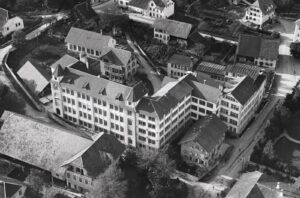

After an embezzlement scandal the previous year lead to the sale of watch assembly operations to ASUAG, the anchor and cylinder movement manufacturing operation of Fabrique d’Ebauches de Bettlach (formerly Ed. Kummer) was taken over by Ebauches SA after reorganization September 23, 1932. This was the second-largest dissident factory. Kummer’s Roskopf movement factory remained independent for 8 more years.

Another dissident, Fabrique d’Ebauches de Fleurier (FEF) is purchased by December and is initially focused on supplying the still-independent Fleurier Watch Co.
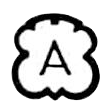
Fabrique d’Ebauches Réunies d’Arogno joins by December.

Charles Berner-Sandoz’ Fabrique d’Ebauches de Peseux, which was previously a partner, joins Ebauches SA by December.

Pedos SA of Renan opens an office in La Chaux-de-Fonds. It would be renamed Derby SA in 1939 and would join Ebauches SA in the 1940s.
1933

Sydney de Coulon becomes managing director of Ebauches SA, a position he would hold until 1964. He was previously secretary of the organization and outside board member of most of the constituent companies, as well as managing director of ASUAG from 1931 to 1933.
1934
Wasa SA of Pieterlen is fined for trying to evade Fidhor export controls even though it is owned by Ebauches SA. The company would be liquidated the following year.
1936
The industrial counters operation of the Ebauches Bernoises group at Sonceboz is purchased by Fritz-Edouard Pfister.

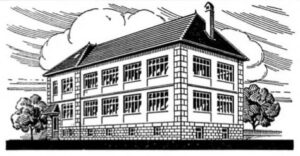
Ebauches SA buys all outstanding shares of Fabrique d’Ebauches de Chézard SA on December 31, 1936. This was one of the few remaining large-scale independent ebauche manufacturers.
1940
Ebauches SA was originally focused only on Swiss lever (anchor) movements, leaving the Roskopf Association to control pin lever exports. This changed in 1940 as Ebauches SA moved into Roskopf movement production as well.

Ebauches SA takes over the Roskopf movement factory of Ed. Kummer in Bettlach. The anchor and cylinder movement factory had been part of the group since 1932.
Ebauches SA takes over the Roskopf movement factory formerly operated by A. Schild SA.
1941

Derby SA closes its Renan factory and, facing financial pressure, allows Ebauches SA to take part ownership of its operations in La Chaux-de-Fonds.


Nouvelle Fabrique SA of Tavannes comes under control of Ebauches SA
1944

Valjoux SA of Les Bioux comes under control of Ebauches SA after John Reymond retired and left the company to his two sons. This is one of the first complicated movement specialists to be purchased by the holding company.
1947
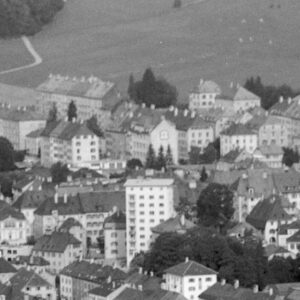

The reorganized Derby SA, now fully owned by Ebauches SA, opens its new factory at Rue du Crêt 5-7 in La Chaux-de-Fonds. It was the only ebauche factory in the watchmaking city, despite watchmakers there consuming over half the output of the holding company at that time.

Unitas of Tramelan introduces the hand-winding Cal. 6497 and Cal. 6498 watch movements. They are revised around 1967 and remain in production today by ETA.
1955

Fabrique d’Horlogerie de Fontainemelon (FHF) introduces the low-cost “standard grade” movement, with the Standard Cal. 608 becoming the leading watch movement in the world, with over 40 million produced.
1958
Vénus acquires the Moutier-based ebauche manufacturing operation of Pierce, including the 1885 Fabrique du Nord and landmark 1915 factory.
1961
The FHF factory in Le Landeron introduces Cal. 4750, the first Swiss electric watch movement. Millions of examples would be produced and used by dozens of Swiss watch brands in the 1960s.
1962

The Nouvelle Fabrique de Tavannes is closed. The old factory would be purchased by the Canton in 1968, shortly after Ebauches SA acquires part of the Tavannes Watch Co. factory across torn, and would become a workshop for psychiatric patients.
1965
The ebauches factory of Durowe SA of Pforzheim, Germany is purchased by a consortium including Ebauches SA. It had been owned by the US Time Corporation (Timex), which retained the finished watch operation known as Durowe, Lacher, and Co. SA (LACO). The firm was an electric watch pioneer, introducing the Laco Electric in 1961.
Ebauches SA merges the three independent factories in Moutier (Fabrique du Nord, Pierce, and Vénus) and commits to build a new modern factory there.
1966
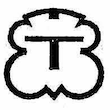
On March 18, Ebauches SA acquires the large factory formerly owned by the Tavannes Watch Co. The firm still owned the “Nouvelle Fabrique” on the hill but it was closed in 1962. They soon disposed of this small factory, switching all operations to a new facility, now called Ebauches Tavannes SA.

Vénus of Moutier is merged into Valjoux of Les Bioux. Manufacture of the former Vénus movements is halted, with only the cam-operated Vénus Cal. 210 remaining in production as the Valjoux Cal. 7730.
1968


The Aurore-Villeret factory is merged into A. Schild SA. It would be closed a decade later.
FHF builds a new modern factory in Corgémont.
Ebauches SA builds a modern factory in Moutier, replacing the former landmark Pierce factory, built in 1915. This is operated by Vénus/Valjoux.
1970

On January 1, Derby SA of La Chaux-de-Fonds and Montilier and the Fabrique d’Ebauches and Centre d’Outillage et Plastique of Landeron are merged to become Ebauches Electroniques SA, with a new factory in Marin planned to centralize production of electric, electronic, and quartz movements.
1971
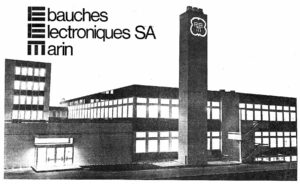
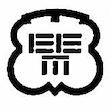
The Ebauches Electroniques SA factory in Marin opens in August. Initially known as “the Derby factory”, the EEM brand would overtake Derby’s in the 1970s and the company’s other factories in La Chaux-de-Fonds, Montilier, and Landeron would be closed.

ETA introduces the Cal. 2800 family, the latest evolution of their automatic movement design. Cal. 2824 would become the highest-volume automatic watch movement produced in Switzerland and the descendants of this series remain in production today.
1973

The revolutionary Valjoux Cal. 7750 automatic chronograph movement is introduced to watch manufacturers. It would enter production in 1974, and millions of examples would be produced in just a few years.
1975



Unitas of Tramelan and Reconvilier is merged into A. Schild SA and the Aurore-Villeret factory is closed.

ETA introduces the “Flatline” 2890 movement family. The Sterna-based movement would become ETA’s primary higher-end watch movement and remains in production today.
1978

Ebauches Tavannes SA is moved into Fabriques d’Ebauches Réunies (FER) alongside Valjoux, Fleurier, Peseux, and Unitas.

A. Schild SA (ASSA) is merged with ETA, reuniting the Schild family movement operations in Grenchen for the first time since 1896.
1979

Ebauches SA merges many factories at its general meeting on April 6, 1979. The Peseux factory becomes a subsidiary of FHF with a new focus on complete watches, electronics, and chemical processes. The Fleurier factory and Valjoux SA are also merged with FHF, with the Valjoux name officially dissolved on June 29.

Fabrique d’Horlogerie de Fontainemelon (FHF) introduces the “mini quartz”, the most compact quartz movement in the world.
1980

Ebauches SA acquires for former Pierce Watch Co. factory in Moutier. Vénus is soon relocated to the more-modern Pierce factory, now reduced to just 50 employees focused on precision machining and component manufacturing.
1982

Most movement makers are merged, with ETA, FHF, and EEM remaining. General management of these companies is focused in Grenchen, marketing is in Marin, and production is concentrated in Grenchen, Fontainemelon, Sion, Les Bioux, and Marin.

The former Derby SA factory in La Chaux-de-Fonds, now part of EEM, is closed, with workers transferred to Marin or laid off. This is the last ebauche factory in that watchmaking city.

Eterna is purchased by SMH to bring ETA under control of the emerging company, with the watch operation spun off to Porsche Design.

On November 10, Ernst Thomke is appointed to be the manager of Ebauches SA amid an overall restructuring of ASUAG.

ETA introduces the updated Cal. 2824-2, the third refinement of the Cal. 2800 family design, introduced in 1971. These movements remain the highest-volume automatic watch movements produced in Switzerland in modern times.
1983

Ebauches SA announces the closure of the Fleurier factory on January 17. It had remained in operation since 1882. Attempts to strike a deal to sell the factory to another watchmaker were rebuffed by the company.
The Vénus operation in Moutier is closed in March. This was the modern 1968 factory on the site of the landmark Pierce building; the original Vénus factory was closed a few years earlier. ETA would re-start operations there a decade later, and currently operates two factories in the town.
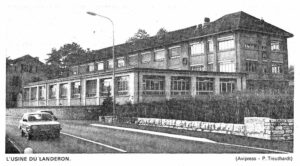
It is abruptly announced that the former Hahn & Cie. factory in Le Landeron, now part of EEM, will be closed, with the workers transferred to Fontaines and Marin.
Establishment of ETA
1985

Ebauches SA is dissolved into SMH, officially becoming ETA SA Fabrique d’Ebauches.
1991
ETA supplier FFB in Bonnétage France is acquired by ETA.
1992
ETA re-starts operations in Motier, where the Vénus factory was located. But ETA’s operation is located at the 1968 factory built on the site of the landmark Pierce building, rather than the original Vénus building. ETA would soon acquire a second factory nearby, and both remain in operation today.
ETA acquires the Parrenin factory in Villiers-le-Lac France, which becomes part of FFB.
1995
The south wing of the Fontainemelon factory is destroyed in a fire. It is re-built two years later.
2003
ETA abandons the name Fabrique d’Ebauches, adopting Fabrique Horlogère Suisse.
Ebauches SA Company Lists
Starting in 1927, Ebauches SA advertised their constituent companies annually in Indicateur Davoine and La Fédération Horlogère. I have collected these below since they provide a timeline of the growth of Ebauches SA in the pre-war years.

